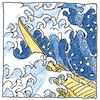Johann Jacob Diesbach
chemistry

|
Prussian blue
Diesbach accidentally added potash tainted with Dippel’s oil to his preparation of red cochineal dye. The result, instead of a red dye, was a distinct blue pigment, insoluble in water, iron ferrocyanide.
Synthetic blues
Egyptian blue and Han blue were the first synthetic pigments—calcium copper silicate in Egypt and barium copper silicate in China. Europe lost how to make Egyptian blue after the Roman era, so artists used dyes that faded while they reserved expensive preparations of finely ground lapis lazuli for Mary’s robes.
Shades of Prussian blue
“The Great Wave off Kanagawa” by Hokusai, the first of his thirty-six views of Mount Fuji, uses three shades of Prussian blue to depict the waves. “Fine Wind, Clear Morning,” the second of his thirty-six views of Mount Fuji, uses three shades of Prussian blue to depict the sky.
Spiritual blue
The Jewish people made the blue dye tekhelet from secretions of the snail Hexaplex trunculus. They say it was the color of the pure sky at noon, the color of the sea, or maybe the color of the sky in moonlight. It’s hard to know exactly what color it was, but it is written that it was like the throne of glory and it was difficult to obtain, especially after they lost their knowledge of how to make it.



The human eye is exquisitely tuned to recognize many blues; however, in a work of art, almost any blue will do, provided the other colors are coordinated with it. Using successfully more than one blue is much more difficult than choosing the first one.
See also in The book of science:
Readings in wikipedia: